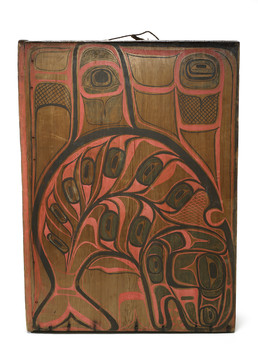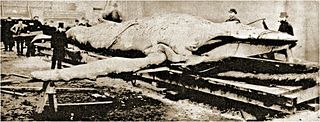| Skywhales | |
|---|---|
| Directed by | Phil Austin and Derek Hayes |
| Written by | Phil Austin and Derek Hayes |
| Produced by | Channel 4 |
| Starring | Robert Llewellyn Bernard Evans [1] |
| Edited by | Lesley Manning |
| Music by | Dirk Higgins |
| Distributed by | Animation City [2] [3] Channel 4 [4] |
Release date |
|
Running time | 11 min. |
| Country | United Kingdom |
| Language | Fictional |
Skywhales is a 1983 British animated drama short film by Derek Hayes and Phil Austin [5] that depicts a fictional society of alien creatures dwelling in the atmosphere of a gas giant. The film is noted for the completeness of its depiction of a fictitious society, including alien language, [6] flora, fauna and social structures and practices. The film has since become a cult classic. [7]
The story begins with a man warning the tribe of approaching skywhales. Drummers warn everybody of the hunt as everyone get prepared to set "sail". One man is found in his home sleeping as the noise wakes him up. He gets ready and is about to take his weapon as he hesitates then decides to go. As he leaves his room, his wife and child see him and try stopping him. He goes through the forest with strange fauna and flora and stops at a path as he sees old pale natives head into a strange silver building. As a sign of respect, he shields his eyes. He is then surprised when his wife pokes him and says that she's coming. As he enters the ship, he sees a native wearing the captain's hat but then he takes his rightful hat while the other looks surprised he came. Then they go on a hunt for the whale. The audience is shown that they live on a floating island high up in a gas giant. The hunters go far away from their home and stop when they hear the whale. Everything is still until a skywhale comes and then destroys the main character's ship. They parachute down to the wife's ship and follow one of the two whales which have escaped. The main character harpoons its head and is congratulated by his team. As it dies they bring it back to their island home where it is completely butchered by nightfall. It then shows the main character and his family at the port where the wife is talking to the son and the main character is tying a rope. Suddenly he turns pale and his eyes black. The wife immediately recognizes what he has become and adopts the custom of shielding her eyes and his son soon follows. By instinct, the main character heads to the building where all those who reach the point in their life to mature go. In the building, there are four guards and a giant hole in the center. Skywhale drawings are all over the floor. As the guards cover their eyes and the wife and son watch at the doorway, he stands there for a while and then falls in the hole. The son gasps and tries to enter but the wife stops him. He looks confused and as they leave, he asks something to the wife who then begins to explain it to him. They show the main character falling through the roots of the island as a cocoon starts forming around his body. By sunrise, he is completely enclosed and hatches as a juvenile skywhale. The viewer then sees the wife with the main character's spear explaining something to the son. Suddenly he hears a skywhale's call, takes the spear, and points it to the whale which he immediately recognizes is his father. The two of them then stand there staring as the whale flies away into the sunrise with the son saluting it with his father's spear. The end credits appear with primitive skywhale cave-drawings in the background.
The story concerns a tribal society of mohawked green-skinned creatures who speak in a complex language of hoots. The hoots are not subtitled, leaving the viewer to determine the meaning from visual context alone. They are intelligent, having a small port with three ships, a small town, clothes, musical instruments and metal weapons and armour. One significant tribal custom introduced early on is the appearance of a subset of the population with dead white skin color and dark black eyes; encountering them causes the people to shield their eyes and let them pass, suggesting an advanced culture. It soon becomes apparent that the society lives in the atmosphere on flying islands, and use pedalled, flying wooden craft to hunt large winged creatures, the skywhales of the title. The creatures have a ship with gas-filled balloons keeping it afloat and it is powered by pedal turning a propeller. The hunters are totally still as they hear the creature. If the skywhales break their ship, they have special gas-filled parachutes that prevent them from falling as another ship comes to their aid. They hunt by using a harpoon on the underside of their ship, which is driven by one of the natives towards its head. Once the skywhale is impaled, the others use a rope to bring it back. Once they return, the natives use every part of the whales. It seems that either the natives get sick or that they are actually larvae of the skywhale, because after the hunt, they develop pale skin and dark black eyes and then go to a building deep in the forest. As a sign of respect, people shield their eyes once they spot one of them. Once inside the building, they stand in front of a giant hole and fall down through the roots of the floating island. While falling, the natives turn into cocoons and hatch only a few hours later into juvenile skywhales. The floating island resembles intestines by the orange roots coming from the underside. The forest on top is orange and contains strange flora that look like trees. Some giant bags of gas are also present. Their buildings are silver and dome-shaped with other complicated structures. On the inside, cave drawings of skywhales cover the walls and floors (it may be that they believe that they are the spirits of their ancestors which of course is partially true).
The Washington Post stated that it was "no different from the usual Saturday morning fare" [8] while The Chicago Tribune compared it to the sci-fi works of Ralph Bakshi. [9]
The Morning Call called it a "Disneyesque fantasy, combing elements of Star Wars and Moby Dick ". [10]

Sea monsters are beings from folklore believed to dwell in the sea and are often imagined to be of immense size. Marine monsters can take many forms, including sea dragons, sea serpents, or tentacled beasts. They can be slimy and scaly and are often pictured threatening ships or spouting jets of water. The definition of a "monster" is subjective; further, some sea monsters may have been based on scientifically accepted creatures, such as whales and types of giant and colossal squid.

Queequeg is a character in the 1851 novel Moby-Dick by American author Herman Melville. The story outlines his royal, Polynesian descent, as well as his desire to "visit Christendom" that led him to leave his homeland. Queequeg is visually distinguished by his striking facial tattoos and tan skin. Ishmael encounters Queequeg in Chapter Four and they become unlikely friends. Once aboard the whaling ship the Pequod, Queequeg becomes the harpooner for the mate Starbuck.

Aboriginal whaling or indigenous whaling is the hunting of whales by indigenous peoples recognised by either IWC or the hunting is considered as part of indigenous activity by the country. It is permitted under international regulation, but in some countries remains a contentious issue. It is usually considered part of the subsistence economy. In some places, whaling has been superseded by whale watching instead. This article deals with communities that continue to hunt; details about communities that have ended the practice may be found in History of whaling.

Street Sharks is an American superhero animated series about the adventures of crime-fighting half-man/half-sharks. It was produced by DIC Productions, L.P. and Bohbot Entertainment, and aired from 1994 to 1997, originally as a part of Bohbot's Amazin' Adventures programming block. before moving to ABC for its final season. The show promoted a line of action figures by Mattel. The creators were David Siegel and Joe Galliani of Mr. Joe's Really Big Productions.

Svend Foyn was a Norwegian whaling, shipping magnate and philanthropist. He pioneered revolutionary methods for hunting and processing whales. Svend Foyn introduced the modern harpoon cannon and brought whaling into a modern age. He is also recognized as a pioneer who introduced sealing to Vestfold County.

Natsilane is the human hero of the "Blackfish" creation myth, one of the Tlingit and Haida stories about how the various supernatural animal species from the Tlingit culture of the American Northwest coast were created. These stories follow an almost dreamtime-like description of humans and other animal species living completely harmoniously. The animals are depicted as demi-gods, and are always referred to as proper singular nouns. There are other similar stories including how Raccoon got the rings on his tail and why Puma hides in the forest so much.

Prehistoric Alaska begins with Paleolithic people moving into northwestern North America sometime between 40,000 and 15,000 years ago across the Bering Land Bridge in western Alaska; a date less than 20,000 years ago is most likely. They found their passage blocked by a huge sheet of ice until a temporary recession in the Wisconsin glaciation opened up an ice-free corridor through northwestern Canada, possibly allowing bands to fan out throughout the rest of the continent. Eventually, Alaska became populated by the Inuit and a variety of Native American groups. Trade with both Asia and southern tribes was active even before the advent of Europeans.

Tico of the Seven Seas is a Japanese anime television series by Nippon Animation. It is about an 11-year-old girl named Nanami Simpson and her best friend Tico, a female orca.
Extraterrestrial is a British-American two-part television documentary miniseries, aired in 2005 in the UK by Channel 4, by the National Geographic Channel in the US on Monday, May 30, 2005 and produced by Big Wave Productions Ltd. The program focuses on the hypothetical and scientifically feasible evolution of alien life on extrasolar planets, providing model examples of two different fictional worlds, one in each of the series's two episodes.

Free Willy 3: The Rescue is a 1997 American family film directed by Sam Pillsbury and written by John Mattson. Released by Warner Bros. under their Warner Bros. Family Entertainment banner, it is the sequel to Free Willy 2: The Adventure Home in addition to being the third film in the Free Willy franchise and final installment of the original storyline as well as the last to be released theatrically. Jason James Richter and August Schellenberg reprise their roles from the previous films while Annie Corley, Vincent Berry and Patrick Kilpatrick joined the cast. The story revolves around Jesse and Randolph attempting to stop a group of whalers, led by its ruthless captain, from illegally hunting Willy while secretly receiving help from an unlikely source involving the captain's young son after an accident changed his view on whales.

The giant squid's elusive nature and fearsome appearance have long made it a popular subject of legends and folk tales. Its popularity as an image continues today with references and depictions in literature, film, television, and video games.
Moby-Dick is an 1851 novel by Herman Melville that describes the voyage of the whaleship Pequod, led by Captain Ahab, who leads his crew on a hunt for the whale Moby Dick. There have been a number of adaptations of Moby-Dick in various media.

Eskimo is a 1933 American Pre-Code drama film directed by W. S. Van Dyke and released by Metro-Goldwyn-Mayer (MGM). It is based on the books Der Eskimo and Die Flucht ins weisse Land by Danish explorer and author Peter Freuchen. The film stars Ray Mala as Mala, Lulu Wong Wing as Mala's first wife Aba, Lotus Long as Mala's second wife Iva, Peter Freuchen as the Ship Captain, W. S. Van Dyke as Inspector White, and Joseph Sauers as Sergeant Hunt.

Flipper and Lopaka is an Australian animated series produced by the Yoram Gross companies: Yoram Gross-Village Roadshow and Yoram Gross-EM.TV. It has previously aired on Australia's Seven Network at various times and has also aired on Australia's ABC3, a channel dedicated to children's television programs.

The Tay Whale, known locally as the Monster, was a humpback whale that swam into the Firth of Tay of eastern Scotland in 1883. It was harpooned in a hunt, but escaped, and was found floating dead off Stonehaven a week later. It was towed into Dundee by a showman, John Woods, and exhibited on a train tour of Scotland and England.

Arabian Nights: Sinbad's Adventures is a 52-episode anime series directed by Fumio Kurokawa and produced by Nippon Animation which was first aired in 1975. The story is based on the children's story "Sinbad the Sailor".

Moby Dick is a 2010 film adaptation of Herman Melville's 1851 novel Moby-Dick. The film is an Asylum production, and stars Barry Bostwick as Captain Ahab. It also stars Renee O'Connor, Michael B. Teh, and Adam Grimes and is directed by Trey Stokes.
The Undersea Adventures of Captain Nemo is a Canadian animated television series of five-minute cartoons produced in 1975 by Rainbow Animation in Toronto, Ontario. The series follows the underwater adventures of Captain Mark Nemo and his two young assistants, Christine and Robbie, in their nuclear-powered submarine, the Nautilus.

Down to the Sea in Ships is a 1949 American seafaring drama film directed by Henry Hathaway, starring Richard Widmark and Lionel Barrymore. The supporting cast includes Dean Stockwell, Cecil Kellaway, Gene Lockhart, and John McIntire. There is no connection between this picture and the silent film by the same name; the only thing they have in common is the title and the setting.

Eye of the Beast is a Canadian monster movie about a young scientist who goes to a small fishing town to find out why fish are not plentiful and ends up in a fight against a giant squid living in Lake Winnipeg. It is the 6th film in the Maneater Series.